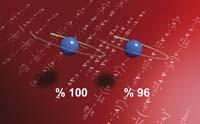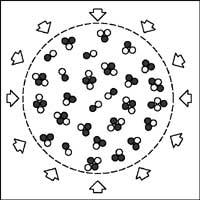Small proton: there is a mistake
2010/09/01 Elhuyar Zientzia Iturria: Elhuyar aldizkaria

The most accurate measurements have been made so far, the proton being 4% lower than expected
Some physicists at the Max Planck Institute have measured more accurately than ever the size of the proton. The result, 0.84184 femtometers, is 4% lower than the previous measurements.
It is not a mere account of accuracy. The difference is greater than the degree of error of the previous measures, which means that, if the last measurement is correct, the previous measurements were not performed correctly. And if this is true, it would be necessary to modify many of the basic principles that so far are considered valid in physics. Therefore, physicists -- theoretical and experimental -- have begun to look for errors in this last measurement. At the moment they have found nothing.
It is a very complex experiment. The proton cannot be measured directly, so physicists must measure the influence of proton size on another feature. Hydrogen atoms are normally used, i.e. protons with an electron around them. According to quantum physics, the electron can only have certain energy levels that depend, among other things, on the size of the proton. They supply energy to the electron by means of a laser and it passes from one energy level to another, and then again lose energy to move to the initial energy level. Physicists measure the amount of energy they have had to take in these jumps and from that energy they calculate the size of the proton.
However, the proton is a very large particle on the side of the electron, so the energy levels of the electron are very close to each other. The jumps made by the electron are small and the measurement accuracy is also very small. However, if we use a muon instead of the electron, the question changes a lot, since the muon is 200 times greater than the electron. According to the complex theory of quantum electrodynamics, this process is based on the quantum fluctuations of the vacuum and the muon is more sensitive to these fluctuations than the electron. Finally, the energy leaps produced by muons are very high and can be measured with great precision.
However, working with muons is difficult. They are particles of the electron family, but they are not stable and dissolve in 2 microseconds. Therefore, physicists at the Max Planck Institute have had to create muons through a particle accelerator, so that hydrogen atoms are bombarded by muons to replace their electrons and perform laser measurement. All this for a maximum time of 2 microseconds. The calculation to deduce the size of the proton from the results of the experiment is also very complex.
Therefore, there are many possibilities that there is some error in the experiment and that in the last measure of the size of the proton there is so much difference from the previous ones. But after reviewing all the details, they have not found any error. According to experts there are three options. One is that the theory of quantum electrodynamics is correct but has been misused in this experiment; the second is that there is some error in the same experiment; and the third is that quantum electrodynamics is not correct. The latter option is the least likely, although it may occur. Jeff Flowers, a physicist at the UK National Physics Laboratory, says: "Directing quantum electrodynamics would mean a philosophical change for physics."

Gai honi buruzko eduki gehiago
Elhuyarrek garatutako teknologia




